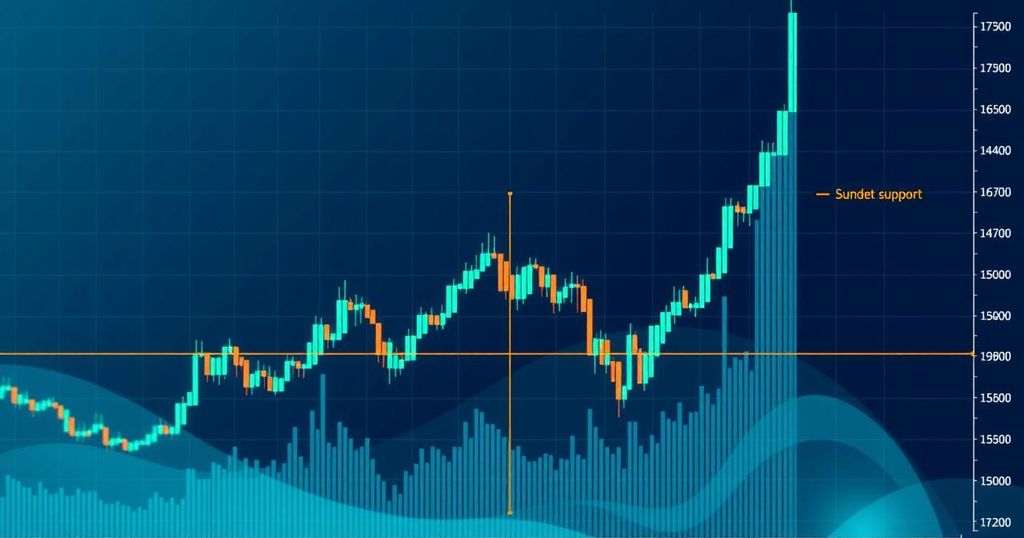Bitcoin Price Stabilizes Above $87,000 with $90K Breakout in Sight
As of March 26, 2025, Bitcoin’s price remains above $87,000, showing signs of stabilization amidst volatility. Key technical indicators suggest a neutral-to-bullish phase, with significant support at $73,800 and resistance at $90,700. Improved market sentiment among retail and institutional investors, combined with rising adoption, positively influences Bitcoin’s trajectory, despite existing risks.
The cryptocurrency market remains highly volatile, with Bitcoin (BTC) drawing significant investor attention. As of March 26, 2025, Bitcoin’s price has stabilized above $87,000, demonstrating a modest recovery following a turbulent first quarter. This stability is characterized by a range of $86,359 to $88,525, reflecting cautious optimism as investors adjust to the market’s recent fluctuations.
Following a major correction earlier in March, where Bitcoin fell from its January high of approximately $109,000 to below $80,000, the asset has shown signs of recovery. The recent price stabilization indicates renewed buying interest among investors, suggesting a growing confidence in Bitcoin’s market potential as concerns over a deeper downturn have eased.
Technical analysis reveals that Bitcoin is in a neutral-to-bullish phase, with several indicators suggesting short-term strength. Notable support lies at $73,800, implying robust buying interest, while critical resistance levels are identified at $90,700 and $93,700; breaking these could initiate a bullish trend. The 50-day moving average nearing a crossover with the 200-day average is a typical bullish signal.
Moreover, the Relative Strength Index (RSI) nearing 58 suggests Bitcoin is neither overbought nor oversold, indicating potential for further upward movement. These indicators collectively point to a cautious rally, with a sustained price movement above $90,000 potentially leading to a test of previous highs.
Market sentiment has improved significantly recently, evidenced by a 6.7% rally in the last five trading days, which reflects enhanced confidence among retail and institutional investors. Factors contributing to this positive sentiment include easing concerns regarding investment regulations and anticipations of more crypto-friendly political initiatives. Institutional investors continue to support Bitcoin, with corporations maintaining substantial holdings and new interest emerging from tech companies.
The comparison between Bitcoin and gold has intensified in 2025, especially as gold outperformed Bitcoin, rising over 15% to reach record highs. Traditional investors have favored gold during economic uncertainties owing to its stability. In contrast, Bitcoin’s volatility has somewhat limited its allure as a safe-haven asset. Nevertheless, Bitcoin’s liquidity, transparency, and advantages in cross-border transactions ensure its relevance in the pursuit of portfolio diversification.
The derivatives market reflects bullish expectations for Bitcoin, with increased open interest in options above $90,000 indicating optimism. Currently, the market assigns a 61% probability of Bitcoin reaching $110,000 by late 2025, though the likelihood for a surge to $200,000 is only 14%. The proximity of large option expirations may influence short-term volatility ahead.
Bitcoin adoption continues to rise among retail and institutional investors, supported by increased trading volumes and advancements in custody solutions and wallet security. Infrastructure developments, including new scaling solutions and energy-efficient mining protocols, contribute to Bitcoin’s long-term viability.
The macroeconomic environment plays a crucial role in shaping Bitcoin’s trajectory, as central banks pursue more accommodative policies amid tempered inflation and economic growth. Investor interest in Bitcoin may surge as conventional assets appear overvalued or underperforming, especially under the influence of changing interest rates and sovereign debt levels.
Nevertheless, several risks linger. Regulatory changes or enforcement actions may disrupt market confidence, while sudden downturns in equities could negatively affect crypto markets. Security breaches in exchanges and geopolitical tensions represent additional threats that could impact market stability. Navigating the current environment necessitates risk management strategies, including diversification and the use of stop-loss orders.
Ultimately, Bitcoin’s ability to reach new highs hinges on macroeconomic conditions, sustained adoption, and the capacity to maintain momentum above key resistance levels. In the dynamically evolving financial landscape, Bitcoin remains an essential asset for observation.
In summary, Bitcoin’s price stabilization above $87,000 illustrates a recovery after significant fluctuations earlier this year, with technical analysis and market sentiment indicating cautiously optimistic trends. Essential support and resistance levels have been identified, and institutional confidence continues to play a crucial role. Despite the challenges posed by regulatory risks and market volatility, Bitcoin’s adoption and robust characteristics provide a promising outlook for its future performance. Continued monitoring of macroeconomic influences and potential risks remains vital for investors in the cryptocurrency sphere.
Original Source: www.analyticsinsight.net








Post Comment